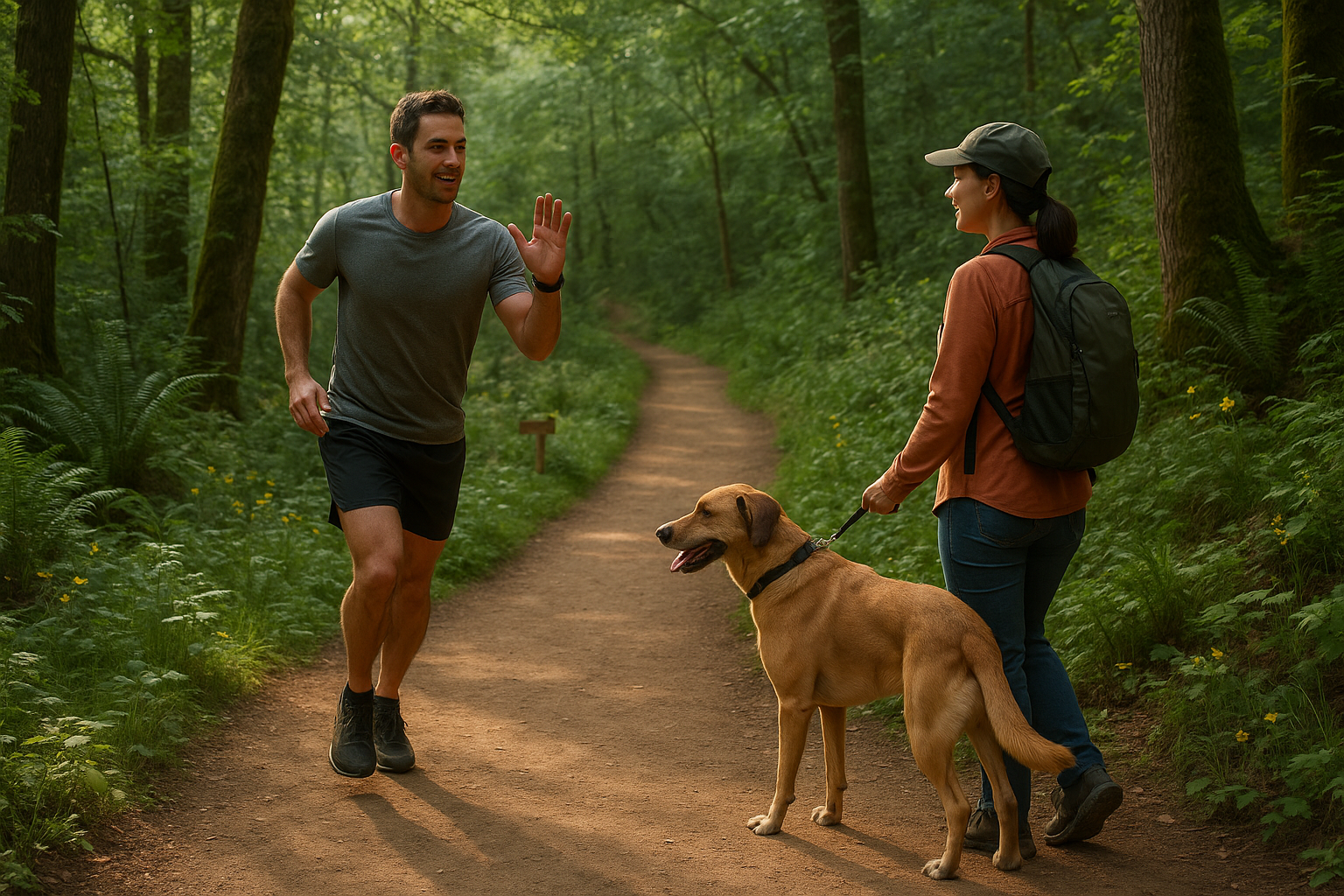But as we wander through winding trails, scale towering peaks, or meander along tranquil rivers, it’s crucial to remember that we are visitors in these wild spaces. 🍃💼
As responsible adventurers, we should strive to protect and respect the natural environment, as well as other trail users. That’s where trail etiquette comes in – a code of conduct to ensure we share the path respectfully and preserve nature for future generations. 🌳🏞️
In this comprehensive guide, we’ll dive deep into the concept of trail etiquette. Whether you’re a seasoned explorer or a novice outdoor enthusiast, you’ll discover essential tips and practices to make your outdoor adventures more harmonious and sustainable. 🌲🚵♀️
Why is Trail Etiquette Important?
Before we delve into the specifics of trail etiquette, let’s pause to understand why it matters. Imagine navigating a crowded trail with hikers who don’t give way, or coming across litter in a pristine wilderness. Not only can these situations cause annoyance, but they can also damage delicate ecosystems and disturb wildlife. Adhering to trail etiquette helps us avoid these pitfalls, making our experiences in nature more enjoyable and respectful. 🐾🌎
Understanding the Basic Rules of Trail Etiquette
The first section of our guide will outline the fundamental rules of trail etiquette. We’ll cover everything from right-of-way norms to noise control, providing clear and straightforward guidelines that you can easily apply on your next adventure. Remember, trail etiquette isn’t about stringent rules; it’s about respect and kindness, both for nature and for others sharing the path. 🌄🚶♂️
Navigating Multi-Use Trails
Next, we’ll discuss how to handle multi-use trails – paths shared by hikers, cyclists, horseback riders, and sometimes even motorized vehicles. These trails require an extra level of awareness and consideration, so we’ll share practical tips to ensure a smooth and courteous journey for everyone involved. 🏇🚴♀️
Minimizing Your Impact on Nature
The final part of our guide will focus on how to minimize your impact on nature during your outdoor adventures. We’ll explore the principles of ‘Leave No Trace’, an international outdoor ethics program aimed at conserving the outdoors by promoting responsible outdoor recreation. From packing out trash to staying on designated trails, these simple yet impactful actions can help preserve nature’s beauty for years to come. 🏕️🐝
Ready to embark on a journey towards more respectful and sustainable outdoor adventures? Let’s dive right into trail etiquette and discover how to share the path and respect nature. 🚀🌍
The Essentials of Trail Etiquette: A Comprehensive Guide
Embracing the great outdoors has always been an alluring escape for many, offering a sense of freedom and adventure. However, as we explore these natural environments, it is crucial to practice appropriate trail etiquette. By respecting the path and the nature around us, we ensure that these trails remain enjoyable for future generations.
In this comprehensive guide, I will walk you through the essentials of trail etiquette, including sharing the path and respecting nature during your outdoor adventures. My aim is to equip you with the necessary knowledge and understanding to become an educated and responsible outdoor enthusiast.
Ready to take your outdoor adventures to the next level? Let’s dive in.
The ‘Leave No Trace’ Principle
At the core of trail etiquette is the ‘Leave No Trace’ principle, an outdoor ethics system that promotes conservation in the outdoors. This principle encourages outdoor enthusiasts to minimize their impact on nature, preserving the environment for future users and the wildlife that calls it home.
The ‘Leave No Trace’ principle revolves around seven core elements: planning ahead and preparing, traveling and camping on durable surfaces, disposing of waste properly, leaving what you find, minimizing campfire impact, respecting wildlife, and being considerate of other visitors.
By adhering to these guidelines, we can contribute to the conservation of our natural resources and ensure the longevity of our trails. For a visual guide on the ‘Leave No Trace’ principle, I recommend watching the video ‘Leave No Trace Principles’ by REI on YouTube.
Sharing the Path: The Importance of Respect and Consideration
Trails are shared spaces, frequented by hikers, bikers, horse riders, and more. Therefore, it’s essential to understand and follow the ‘yielding’ rules on the trail to ensure everyone’s safety and enjoyment.
As a general rule, bikers should yield to hikers and horse riders, and hikers should yield to horse riders. However, in practice, it’s often easier for hikers to step aside for bikers due to their speed. Communication is key in these scenarios – a simple ‘hello’ or ‘coming through’ can go a long way in preventing accidents.
To compare the different trail rules and considerations based on user types, check out the table below:
| User Type | Trail Rules | Considerations |
| Hikers | Stay on the trail, yield to horse riders, follow ‘Leave No Trace’ principles | Avoid loud noises, keep pets on a leash, avoid sensitive habitats |
| Bikers | Yield to hikers and horse riders, follow designated trails | Control speed, announce your presence, avoid skidding |
| Horse Riders | Use equestrian-approved trails, follow ‘Leave No Trace’ principles | Control your horse, announce your approach, clean up after your horse |
Respecting Wildlife: Do’s and Don’ts
Encountering wildlife is one of the most thrilling aspects of outdoor adventures. However, it’s crucial to remember that we are guests in their home. As such, we should strive to observe and appreciate wildlife from a distance without causing unnecessary stress or harm.
Feeding wildlife, for example, is a big no-no. Not only does it encourage animals to become dependent on human food, but it can also expose them to various diseases. In some parks and reserves, it’s even illegal.
Similarly, approaching or touching wildlife is strongly discouraged. Not only can it be dangerous for you, but it can also be distressing for the animals. It’s always best to use binoculars or telephoto lenses for close-up views. Remember, your safety and the welfare of the wildlife should always be your top priorities.
Maintaining the Trail: How You Can Help
Maintaining the trails is a shared responsibility among all users. By following the ‘Leave No Trace’ principles, disposing of waste properly, and respecting trail rules, we can all contribute to the preservation of these paths.
Additionally, many local organizations and communities organize trail maintenance days where volunteers can help with tasks like clearing debris, repairing trail surfaces, and installing signage. Participating in these events can be a great way to give back to the community and ensure the sustainability of our trails.
Finally, reporting trail issues to the relevant authorities can also be extremely helpful. Whether it’s a fallen tree, damaged sign, or a trail washout, these reports can help get issues resolved more quickly and prevent potential accidents.
Parting Thoughts
As we venture out into the great outdoors, let us remember that these natural spaces are a shared resource. By practicing appropriate trail etiquette, we not only ensure our own enjoyment but also contribute to the preservation of these beautiful environments for future generations.
So the next time you embark on an outdoor adventure, remember these guidelines and let’s do our part in preserving the trails for everyone to enjoy. Happy trails!

Conclusion
In this article, we’ve travelled quite a journey through the multifaceted realm of software engineering, diving deep into its core concepts, its paramount importance in today’s digital era, and the cutting-edge practices that shape the field.
We started by unraveling the fundamental principles of software engineering, shedding light on its key processes and methodologies, including requirements gathering, system design, coding, testing, and maintenance. The aim was not only to provide a high-level overview but also to emphasize the intricacy and complexity of these processes, thereby highlighting the skills and expertise required for success in this domain. 💻👨💻
Next, we moved on to discuss the overarching importance of software engineering. As we live in an era where software applications underpin virtually all aspects of our daily lives, the role of software engineers has become more crucial than ever. From designing user-friendly apps that simplify our tasks to developing sophisticated systems that drive business operations, their contributions are truly immense. 🌍🚀
Delving deeper, we explored some of the state-of-the-art practices in software engineering, such as Agile development, DevOps, and microservices. These practices not only maximize efficiency and productivity but also foster a culture of collaboration, thereby enabling teams to deliver high-quality software products in a timely manner. 🛠️🎯
To ensure the theoretical concepts were well understood, we also shared practical insights and real-world examples throughout the article. This was done to bridge the gap between theory and practice and to provide a more comprehensive understanding of the subject matter. 📚🔍
In conclusion, software engineering is not just about writing code. It’s a multidisciplinary field that combines technical skills, analytical thinking, and creativity. It’s about transforming ideas into reality and making a difference in people’s lives. It’s a field that’s constantly evolving, driven by innovation and technological advancements. And as software engineers, it’s our responsibility to keep up with these changes, to continuously learn and grow, and to push the boundaries of what’s possible. 🚀💡
So, whether you’re a seasoned professional or an aspiring software engineer, I hope this article has provided you with valuable insights and a renewed sense of inspiration. Feel free to share your thoughts, experiences, or questions in the comments section below. You can also share this article with your colleagues or friends who might find it useful. After all, learning is a journey that’s best shared. 📘👥
For further reading, you can check out the following resources:
[Software Engineering: A Practitioner’s Approach](https://www.amazon.com/Software-Engineering-Practitioners-Roger-Pressman/dp/0073375977) by Roger S. Pressman
[The Pragmatic Programmer: Your Journey To Mastery](https://www.amazon.com/Pragmatic-Programmer-journey-mastery-Anniversary/dp/0135957052) by Andrew Hunt and David Thomas.
Thank you for your time, and remember, keep coding, keep learning, and keep pushing the boundaries of innovation! 🚀🎓🌟
References: Pressman, R.S. (2010). Software Engineering: A Practitioner’s Approach. McGraw-Hill. | Hunt, A., & Thomas, D. (2019). The Pragmatic Programmer: Your Journey To Mastery. Addison-Wesley Professional.



